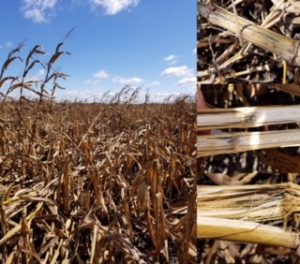Heavy rains and wind have started to take a toll on corn that has compromised stalks. Many factors can contribute to stalk decline – I am going to focus on the plant pathogenic causes, but note abiotic stresses factors could also play a role such as drought and flooding. Either way as stalk tissue becomes compromises below the main ear; the stalk may become brittle or weak and be prone to lodging.
There are a number of pathogens that can cause stalk rot including, Anthracnose, Bacteria, Charcoal, Diplodia, Fusarium, Gibberella, and Pythium. Some of these stalk rots have very characteristic symptoms that can help identify the specific problem, while others may require laboratory diagnosis.
What can you do now – check field by using the Push or Pinch Test by evaluating 20 plants in at least five random areas in a field.
Pinch Test – grab the stalk somewhere between the lowest two internodes and pinch between your fingers to see if the stalk is strong enough to handle the force – if the stalk collapses, it fails
Push Test – push the stalk to a 30 degree angle – if it pops back up when released, it passes the test, if not it fails.
Threshold: 10% or more of the stalks fail then consider early harvesting to avoid risk for lodging.

Figure 1. Severe lodging after a rainstorm many stalks with symptoms of Anthracnose stalk rot. Photos Darcy Telenko.
What can you do in the future – management options will depend on the specific disease (see table 1). Production practices that promote good plant health including balanced fertilization, appropriate plant populations, and good water management can reduced stresses that might predispose corn to stalk rot. In addition, these key management tools can help mitigate future stalk rot issues.
- Properly diagnosis the stalk rot pathogen. (Samples can be submitted to the Purdue Plant and Pest Diagnostic Lab (https://www.extension.purdue.edu/extmedia/BP/BP-89-W.pdf has a more detailed description of each stalk rot)
- Select hybrids with resistance if available.
- Crop Rotation – rotating to non-host crop will help reduce stalk rot potential in a field. Note that Charcoal rot and Gibberella stalk rot can infect other rotational crops in Indiana
- Tillage – burying infected crop residue will encourage more rapid desiccation and help reduces risk of overwintering in crop residue.
- Good soil drainage and reduced compaction.
Foliar Fungicides – applying foliar fungicides can help protect crop from foliar diseases that could predispose plant to stalk rot when present, but devoid of foliar disease pressure fungicides applications have not consistently been found to help reduce stalk rot.
Table 1. Stalk rot pathogens, identifying characteristics, and management options.
| Management optionsz | |||||
|---|---|---|---|---|---|
| Stalk rot | Characteristics | Resistancey | Rotationx | Tillagex | Other |
| Anthracnose | Distinctive blackening of the stalk rind, loss of pith leads to shredded interior | x | x | x | Strong stalks, reduced susceptibility to foliar diseases, and production practices that promote good plant health may reduce potential for lodging |
| Bacteria | Slimy, water soaked outer rind and pith | fall | Good drainage and plant health practices | ||
| Charcoal | Silver grey rind, peppered with microsclerotia – grainy, gray in color | x | Many hosts. Rotation not as effective since microsclerotia can survive for many years | ||
| Diplodia | Many small, black pycnidia embedded in rind of lower internode- that cannot be scrapped off with thumbnail, white mold might appear in wet conditions, shredded pith | x | x | x | Strong stalks, reduced susceptibility to foliar diseases, and production practices that promote good plant health may reduce potential for lodging |
| Fusarium | Dark lesions, external brown streaks on lower internode, internal shredding, sometimes a pale-pink to salmon color on rotted tissue | x | x | x | Strong stalks, reduced susceptibility to foliar diseases, and production practices that promote good plant health may reduce potential for lodging |
| Gibberella | Small, black spots (perithecia) on internodes and nodes – these can be scrapped off with thumbnail, pink discoloration and shredding in pith | x | x | x | Strong stalks, reduced susceptibility to foliar diseases, and production practices that promote good plant health may reduce potential for lodging |
| Physoderma | Infected nodes will snap when pushed, node is black and rotten. | Maybe | Maybe | Strong stalks, reduced susceptibility to foliar diseases, and production practices that promote good plant health may reduce potential for lodging | |
| Pythium | Decay of first internode about soil – soft, brown, water-soaked pith. Stalk may twist. Typically no odor. | Strong stalks, reduced susceptibility to foliar diseases, and production practices that promote good plant health may reduce potential for lodging | |||
| zManagement options that could be considered for future crops.
y X=Resistance may be available in some hybrids for the specific disease. x Rotation and tillage can reduce inoculum potential in the field. |
|||||


